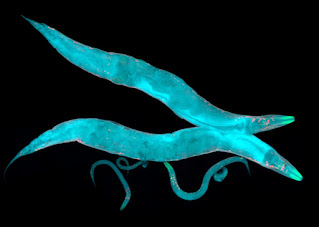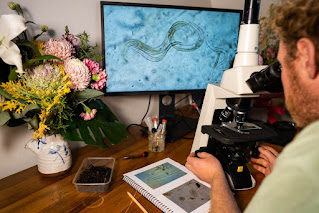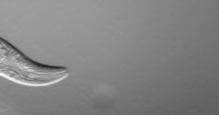It’s September, and here at ARBICO, it’s Beneficial Nematode season. Every year we put our Beneficial Nematodes on sale at this time to encourage our customers to get them in their garden before winter and get a jump on any soil-dwelling pests looking for a place to overwinter. If you’ve been using them, you know how big a difference they make and if you are not familiar with what they can do, now is the time to try them out. Beneficial Nematodes really should be considered an essential garden tool. To set your thought on these tiny beings, I’ve gathered some interesting tidbits about nematodes in general.
THEY ARE LITERALLY EVERYWHERE
 |
| Antarctic Soil Nematodes |
According to a study done in 2019, there are 57 billion nematodes for every human on our planet and they make up four out of every five animals. The type of nematode that we sell here at ARBICO are the type that prey on insects, known as Entomopathogenic Nematodes (EPNs), but they are only one of the many varieties found in the land, water and bodies of living things on earth (for more on this, see my nematode blog from 2019). The air is the only place in our world that they do not inhabit (they have no wings). In the aforementioned article, the researchers discovered that the majority of nematodes actually live in artic and sub-artic environments and not the rainforest, as one might expect (see a fun video here). An oft-repeated anecdote about the ubiquitous nematode says that if you were to remove all but nematodes from the planet, Earth’s topography would still be recognizable in the nematode mass that remains .
THEY ARE CLIMATE WARRIORS
Soil nematodes naturally create healthy soil and are essential to a thriving ecosystem. They aid in maintaining a healthy soil structure by aerating it, play a huge role in decomposition, and are active participants in cycling carbon and nutrients. The artic nematode scientists I mentioned before determined that a large and healthy nematode population is directly related to soil carbon. In other words, the more nematodes there are the more carbon is kept in the soil. There are scientists out there right now hoping to find a way to address climate change by studying how nematodes use carbon and their effect on its emissions.THEY'VE BEEN KEY IN IMPORTANT SCIENCE
 |
| Caenorhabditis elegans |
THEY CAN BE ZOMBIES
Okay, so not exactly zombies because they don’t eat brains; but they can go into a living-dead state. They do this through a process called cryptobiosis, whereby they are able to suspend all their metabolic activity. Everything just stops. This extreme hibernation is as close to death as something alive can be. Nematodes go into this state when environmental conditions are extreme and unfavorable and will stay in it until conditions improve. This can make it challenging to fight damaging nematodes, but this ability is another source of interest to scientists, especially climate scientists. We all know we are in a time of extreme climate change, so there is hope that we can learn something about how to survive from the humble nematode. There are other creatures who have the ability to hibernate in this way, this short article gives some great examples.Take Care
Submitted by Pam










Love your blogs they are so informative. I am excited to get some of these little guys and put them to work but it needs to cool down a little more don't want to kill the little dudes before they get to work.
ReplyDelete